Page 404 of 587
Tire Service Kit — If EquippedIf a tire is punctured, you can make a first emergency
repair using the Tire Service Kit located in the rear
storage compartment inside the storage container.
Tire punctures of up to 1/4” (6 mm) can be repaired; the
kit can be used in all weather conditions. Do not remove
the foreign object from the punctured tire, i.e., screw or
nail.
Remove the Tire Service Kit from the vehicle, take it out
from the bag and place it near the punctured tire. Screw
the clear flexible filling tube to the tire valve.
WARNING!
•Do not attempt to seal a tire on the side of the
vehicle closest to traffic. Pull far enough off the
road to avoid the danger of being hit when using
the Tire Service Kit.
(Continued)
Tire Service Kit Components1 — Power Plug (located on bottom side of Tire Service Kit)
2 — Sealant Hose (Clear)
3 — Power Button
4 — Pressure Gauge
5 — Sealant Bottle 402 IN CASE OF EMERGENCY
Page 405 of 587
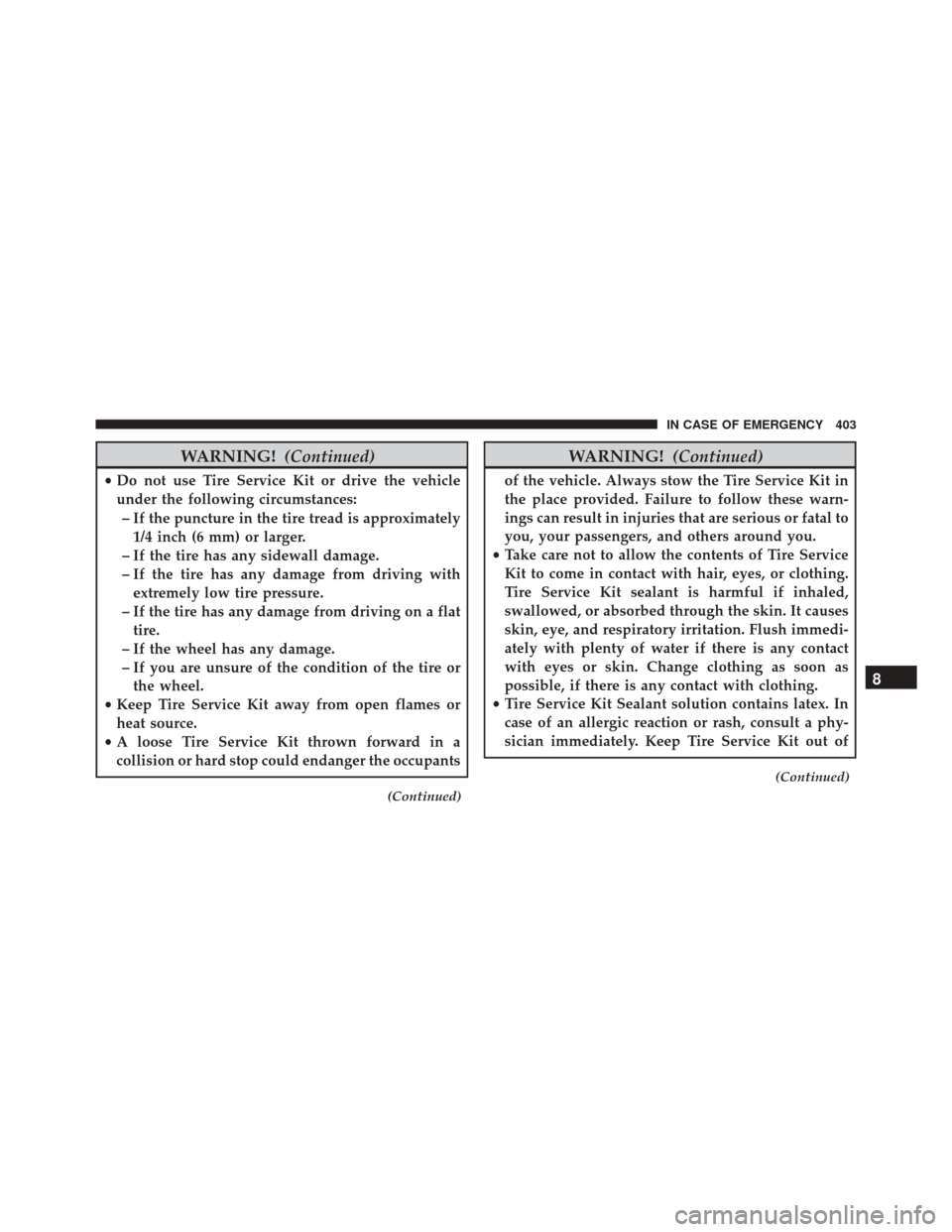
WARNING!(Continued)
•Do not use Tire Service Kit or drive the vehicle
under the following circumstances:
– If the puncture in the tire tread is approximately 1/4 inch (6 mm) or larger.
– If the tire has any sidewall damage.
– If the tire has any damage from driving with extremely low tire pressure.
– If the tire has any damage from driving on a flat tire.
– If the wheel has any damage.
– If you are unsure of the condition of the tire or the wheel.
• Keep Tire Service Kit away from open flames or
heat source.
• A loose Tire Service Kit thrown forward in a
collision or hard stop could endanger the occupants
(Continued)
WARNING! (Continued)
of the vehicle. Always stow the Tire Service Kit in
the place provided. Failure to follow these warn-
ings can result in injuries that are serious or fatal to
you, your passengers, and others around you.
• Take care not to allow the contents of Tire Service
Kit to come in contact with hair, eyes, or clothing.
Tire Service Kit sealant is harmful if inhaled,
swallowed, or absorbed through the skin. It causes
skin, eye, and respiratory irritation. Flush immedi-
ately with plenty of water if there is any contact
with eyes or skin. Change clothing as soon as
possible, if there is any contact with clothing.
• Tire Service Kit Sealant solution contains latex. In
case of an allergic reaction or rash, consult a phy-
sician immediately. Keep Tire Service Kit out of
(Continued)
8
IN CASE OF EMERGENCY 403
Page 406 of 587
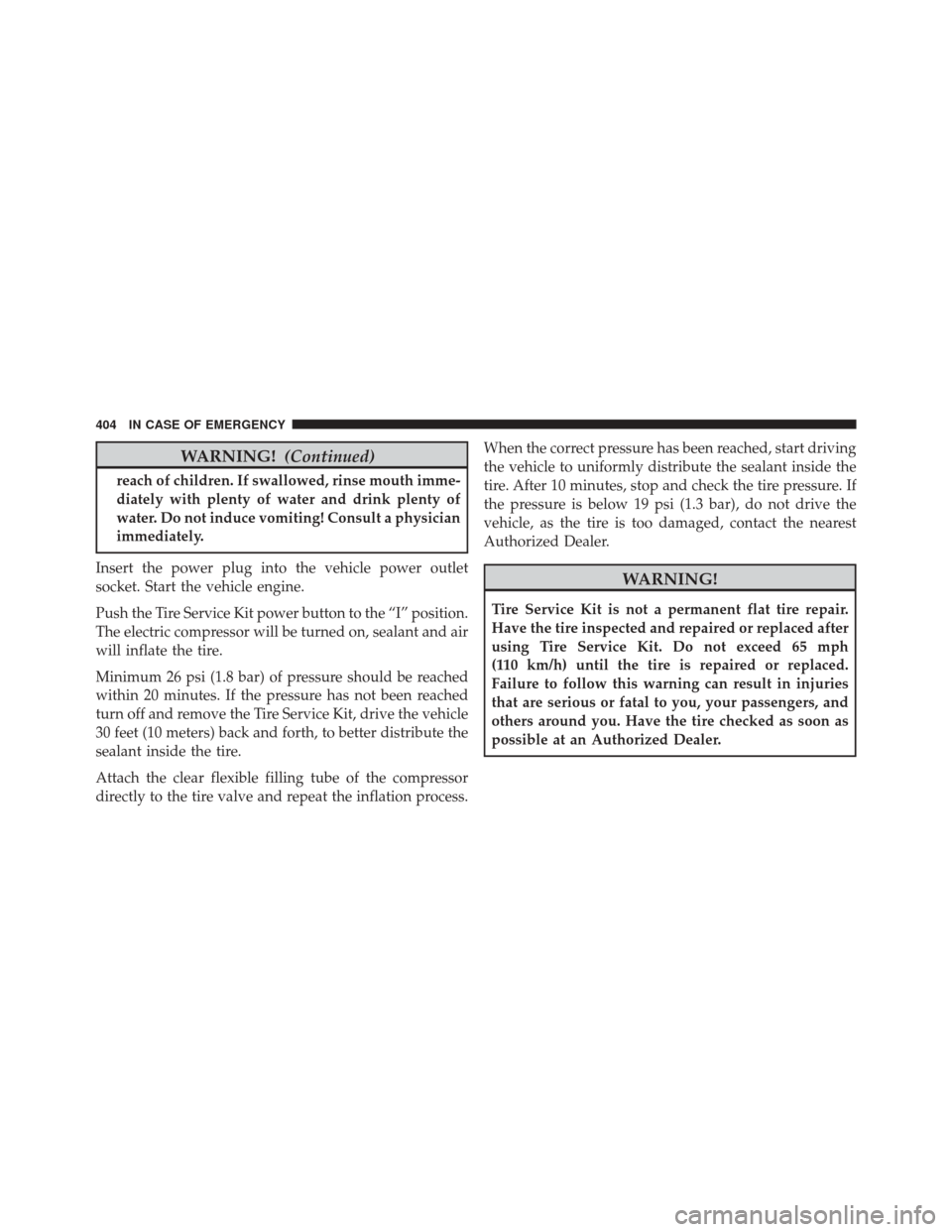
WARNING!(Continued)
reach of children. If swallowed, rinse mouth imme-
diately with plenty of water and drink plenty of
water. Do not induce vomiting! Consult a physician
immediately.
Insert the power plug into the vehicle power outlet
socket. Start the vehicle engine.
Push the Tire Service Kit power button to the “I” position.
The electric compressor will be turned on, sealant and air
will inflate the tire.
Minimum 26 psi (1.8 bar) of pressure should be reached
within 20 minutes. If the pressure has not been reached
turn off and remove the Tire Service Kit, drive the vehicle
30 feet (10 meters) back and forth, to better distribute the
sealant inside the tire.
Attach the clear flexible filling tube of the compressor
directly to the tire valve and repeat the inflation process. When the correct pressure has been reached, start driving
the vehicle to uniformly distribute the sealant inside the
tire. After 10 minutes, stop and check the tire pressure. If
the pressure is below 19 psi (1.3 bar), do not drive the
vehicle, as the tire is too damaged, contact the nearest
Authorized Dealer.
WARNING!
Tire Service Kit is not a permanent flat tire repair.
Have the tire inspected and repaired or replaced after
using Tire Service Kit. Do not exceed 65 mph
(110 km/h) until the tire is repaired or replaced.
Failure to follow this warning can result in injuries
that are serious or fatal to you, your passengers, and
others around you. Have the tire checked as soon as
possible at an Authorized Dealer.
404 IN CASE OF EMERGENCY
Page 407 of 587
If the pressure is at 19 psi (1.3 bar) or above repeat the
inflation process to reach the correct tire pressure and
continue driving.
Peel off the warning label from the bottle and place it on
the dashboard as a reminder to the driver that the tire has
been treated with Tire Service Kit.
WARNING!
The metal end fitting from Power Plug may get hot
after use, so it should be handled carefully.
NOTE: Replace the sealant canister prior to the expira-
tion date at your authorized dealer.
WARNING!
Store the sealant canister in its special compartment,
away from sources of heat. Failure to follow this
WARNING may result in sealant canister rupture
and serious injury or death.
Tire Service Kit Expiration Date Location8
IN CASE OF EMERGENCY 405
Page 415 of 587
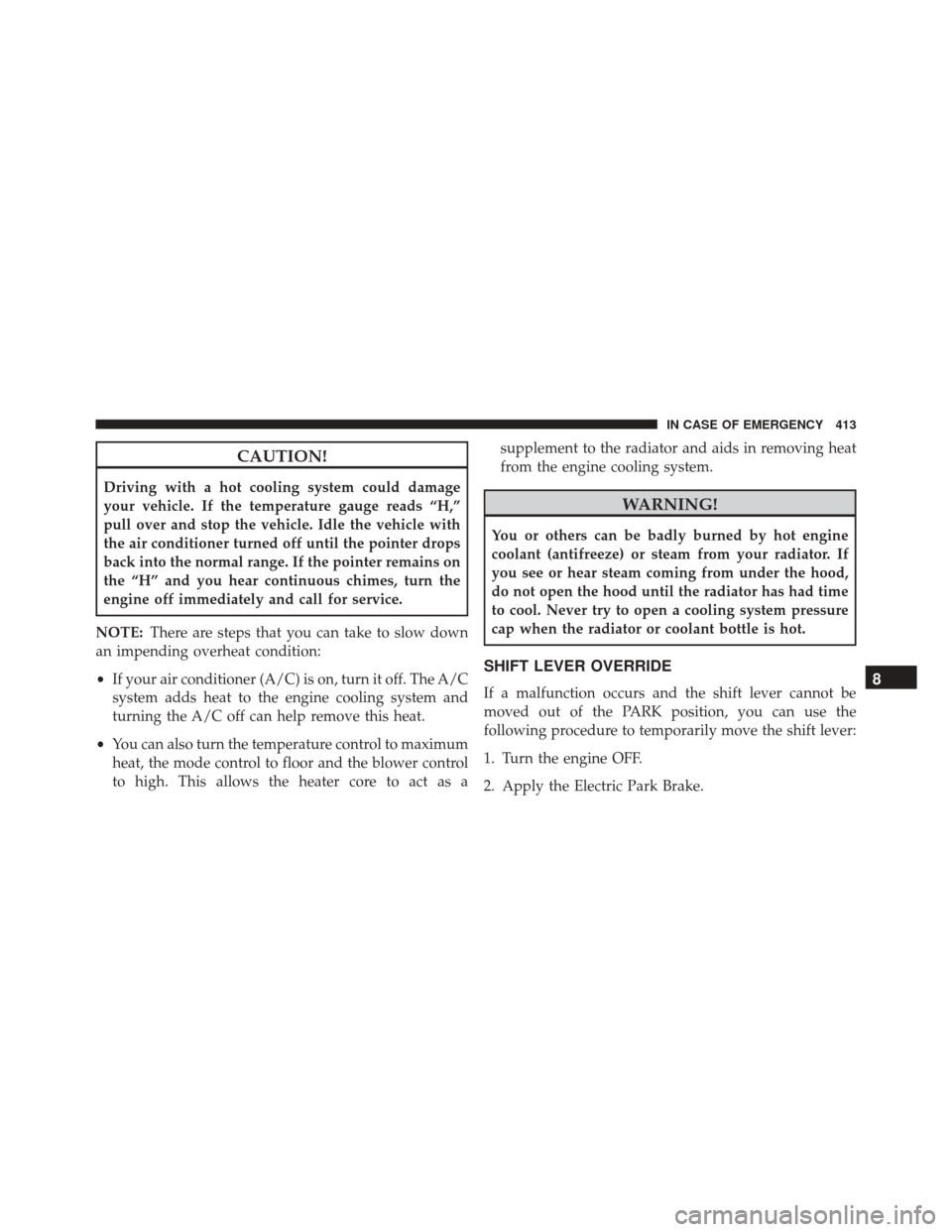
CAUTION!
Driving with a hot cooling system could damage
your vehicle. If the temperature gauge reads “H,”
pull over and stop the vehicle. Idle the vehicle with
the air conditioner turned off until the pointer drops
back into the normal range. If the pointer remains on
the “H” and you hear continuous chimes, turn the
engine off immediately and call for service.
NOTE: There are steps that you can take to slow down
an impending overheat condition:
• If your air conditioner (A/C) is on, turn it off. The A/C
system adds heat to the engine cooling system and
turning the A/C off can help remove this heat.
• You can also turn the temperature control to maximum
heat, the mode control to floor and the blower control
to high. This allows the heater core to act as a supplement to the radiator and aids in removing heat
from the engine cooling system.
WARNING!
You or others can be badly burned by hot engine
coolant (antifreeze) or steam from your radiator. If
you see or hear steam coming from under the hood,
do not open the hood until the radiator has had time
to cool. Never try to open a cooling system pressure
cap when the radiator or coolant bottle is hot.
SHIFT LEVER OVERRIDE
If a malfunction occurs and the shift lever cannot be
moved out of the PARK position, you can use the
following procedure to temporarily move the shift lever:
1. Turn the engine OFF.
2. Apply the Electric Park Brake.8
IN CASE OF EMERGENCY 413
Page 421 of 587
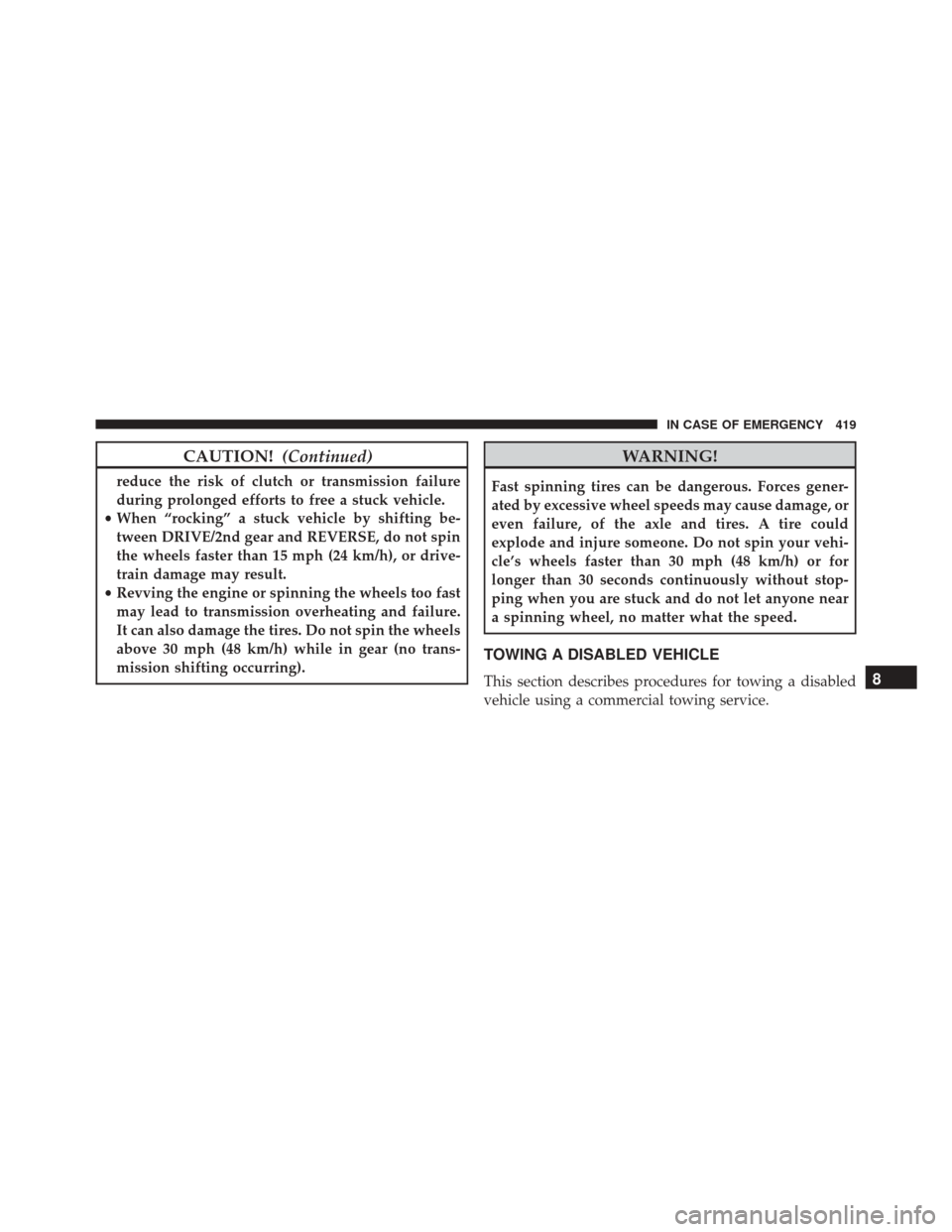
CAUTION!(Continued)
reduce the risk of clutch or transmission failure
during prolonged efforts to free a stuck vehicle.
• When “rocking” a stuck vehicle by shifting be-
tween DRIVE/2nd gear and REVERSE, do not spin
the wheels faster than 15 mph (24 km/h), or drive-
train damage may result.
• Revving the engine or spinning the wheels too fast
may lead to transmission overheating and failure.
It can also damage the tires. Do not spin the wheels
above 30 mph (48 km/h) while in gear (no trans-
mission shifting occurring).
WARNING!
Fast spinning tires can be dangerous. Forces gener-
ated by excessive wheel speeds may cause damage, or
even failure, of the axle and tires. A tire could
explode and injure someone. Do not spin your vehi-
cle’s wheels faster than 30 mph (48 km/h) or for
longer than 30 seconds continuously without stop-
ping when you are stuck and do not let anyone near
a spinning wheel, no matter what the speed.
TOWING A DISABLED VEHICLE
This section describes procedures for towing a disabled
vehicle using a commercial towing service.8
IN CASE OF EMERGENCY 419
Page 427 of 587
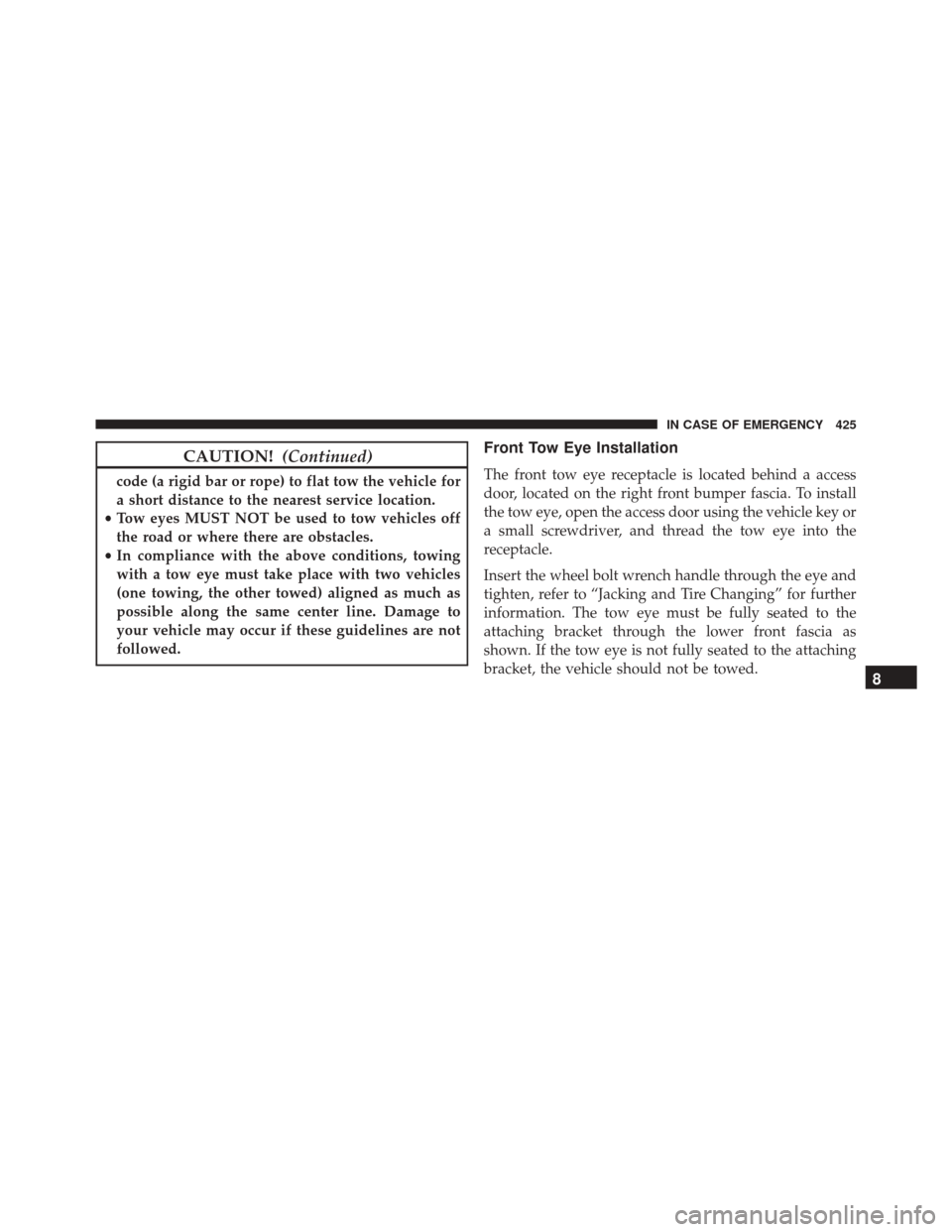
CAUTION!(Continued)
code (a rigid bar or rope) to flat tow the vehicle for
a short distance to the nearest service location.
• Tow eyes MUST NOT be used to tow vehicles off
the road or where there are obstacles.
• In compliance with the above conditions, towing
with a tow eye must take place with two vehicles
(one towing, the other towed) aligned as much as
possible along the same center line. Damage to
your vehicle may occur if these guidelines are not
followed.
Front Tow Eye Installation
The front tow eye receptacle is located behind a access
door, located on the right front bumper fascia. To install
the tow eye, open the access door using the vehicle key or
a small screwdriver, and thread the tow eye into the
receptacle.
Insert the wheel bolt wrench handle through the eye and
tighten, refer to “Jacking and Tire Changing” for further
information. The tow eye must be fully seated to the
attaching bracket through the lower front fascia as
shown. If the tow eye is not fully seated to the attaching
bracket, the vehicle should not be towed.
8
IN CASE OF EMERGENCY 425
Page 431 of 587
MAINTAINING AND CARING FOR YOUR VEHICLE
CONTENTS
�EMISSIONS INSPECTION AND MAINTENANCE
PROGRAMS ......................... .431
� REPLACEMENT PARTS ..................432
� DEALER SERVICE ..................... .432
� MAINTENANCE SCHEDULE ..............433
▫ Maintenance Chart .....................435
� ENGINE COMPARTMENT — 1.4L TURBO
ENGINE ............................ .444
� ENGINE COMPARTMENT — 2.4L ENGINE . . . .445
� MAINTENANCE PROCEDURES ...........446▫
Engine Oil ......................... .446
▫ Engine Oil Filter ..................... .449
▫ Engine Air Cleaner Filter ................449
▫ Maintenance-Free Battery ...............450
▫ Air Conditioner Maintenance .............451
▫ Body Lubrication .....................452
▫ Wiper Blades ....................... .453
▫ Adding Washer Fluid ..................455
▫ Exhaust System ..................... .456
▫ Cooling System ..................... .458
9